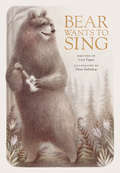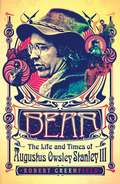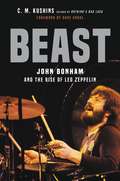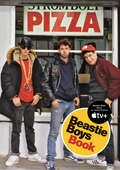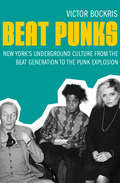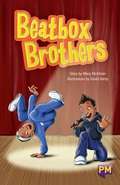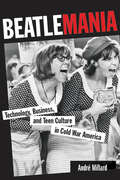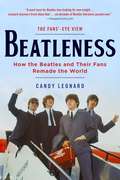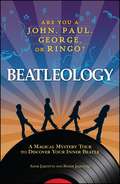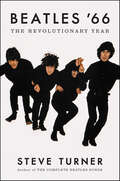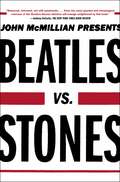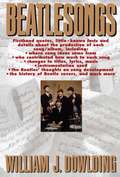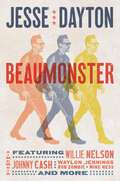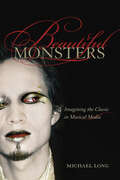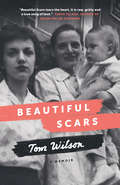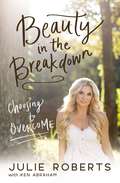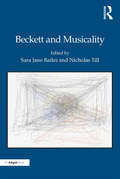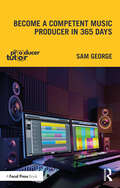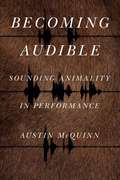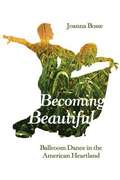- Table View
- List View
Bear Wants to Sing
by Cary FaganBear wants to sing his song, but the other animals won't give him a chance to perform his masterwork in this delightful picture book companion to the critically acclaimed King Mouse.A bear finds a ukulele in the woods. It makes a nice sound -- PLINK! -- and inspires him to write his own song. His friend Mouse would love to hear it. But Bear isn't the only animal in the forest to find musical inspiration that day, and Snake, Crow and Tortoise keep taking his turn to perform. When they finally give him the opportunity and meet his song with less enthusiasm than he'd like, the discouraged bear shelves his music career forever . . . but the kindness, empathy and appreciation of his best friend will prove that his art deserves recognition and can even inspire others.This dryly humorous and sweetly profound collaboration between two critically acclaimed children's book creators, a follow-up to the masterful King Mouse, has the makings of a modern classic.
Bear: The Life and Times of Augustus Owsley Stanley III
by Robert GreenfieldThe creator of the dancing bear logo and designer of the Wall of Sound for the Grateful Dead, Augustus Owsley Stanley III, better known by his nickname, Bear, was one of the most iconic figures in the cultural revolution that changed both America and the world during the 1960s.Owsley's high octane rocket fuel enabled Ken Kesey and his Merry Pranksters to put on the Acid Tests. It also powered much of what happened on stage at Monterey Pop. Owsley turned on Pete Townshend of The Who and Jimi Hendrix. The shipment of LSD that Owsley sent John Lennon resulted in The Beatles' Magical Mystery Tour album and film. Convinced that the Grateful Dead were destined to become the world's greatest rock 'n' roll band, Owsley provided the money that kept them going during their early days. As their longtime soundman, he then faithfully recorded many of the Dead's greatest live performances and designed the massive space age system that came to be known as the Wall of Sound.Award-winning author and biographer Robert Greenfield's definitive biography of this Grateful Dead legend masterfully takes us through Owsley's incredible life and times to bring us a full picture of this fascinating man for the first time.
Beast: John Bonham and the Rise of Led Zeppelin
by C. M. KushinsThe first full-length narrative biography of Led Zeppelin's John Bonham, considered by many to be one of the greatest drummers in rock history, and a genuine wild man of epic (and sadly fatal) proportions. Beast: John Bonham and the Rise of Led Zeppelin is the first-ever biography of the iconic John Bonham, considered by many to be one of the greatest (if not THE greatest) rock drummer of all time. Bonham first learned to play the drums at the age of five, and despite never taking formal lessons, began drumming for local bands immediately upon graduating from secondary school. By the late 1960s, Bonham was looking for a more solid gig in order to provide his growing family with a more regular income. Meanwhile, following the dissolution of the popular blues rock band The Yardbirds, lead guitarist Jimmy Page sought the company of new bandmates to help him record an album and tour Scandinavia as the New Yardbirds. A few months later, Bonham was recruited to join the band who would eventually become known as Led Zeppelin-and before the year was out, Bonham and his three bandmates would become the richest rock band in the world. In their first year, Led Zeppelin released two albums and completed four US and four UK concert tours. As their popularity exploded, they moved from ballrooms and smaller clubs to larger auditoriums, and eventually started selling out full arenas. Throughout the 1970s, Led Zeppelin reached new heights of commercial and critical success, making them one of the most influential groups of the era, both in musical style and in their approach towards the workings of the entertainment industry. They added extravagant lasers, light shows, and mirror balls to their performances; wore flamboyant and often glittering outfits; traveled in a private jet airliner and rented out entire sections of hotels; and soon become the subject of frequently repeated stories of debauchery and destruction while on tour. In 1977, the group performed what would be their final live appearance in the US, following months of rising fervor and rioting from their fandom. And in September of 1980, Bonham-plagued by alcoholism, anxiety, and the after-effects of years of excess-was found dead by his bandmates. To this day, Bonham is posthumously described as one of the most important, well-known, and influential drummers in rock, topping best of lists describing him as an inimitable, all-time great. As Adam Budofsky, managing editor of Modern Drummer, explained, "If the king of rock 'n' roll was Elvis Presley, then the king of rock drumming was certainly John Bonham."
Beastie Boys Book
by Michael Diamond Adam HorovitzA panoramic experience that tells the story of Beastie Boys, a book as unique as the band itself—by band members ADROCK and Mike D, with contributions from Amy Poehler, Colson Whitehead, Spike Jonze, Wes Anderson, Luc Sante, and more. Formed as a New York City hardcore band in 1981, Beastie Boys struck an unlikely path to global hip hop superstardom. <P><P>Here is their story, told for the first time in the words of the band. Adam “ADROCK” Horovitz and Michael “Mike D” Diamond offer revealing and very funny accounts of their transition from teenage punks to budding rappers; their early collaboration with Russell Simmons and Rick Rubin; the debut album that became the first hip hop record ever to hit #1, Licensed to Ill—and the album’s messy fallout as the band broke with Def Jam; their move to Los Angeles and rebirth with the genre-defying masterpiece Paul’s Boutique; their evolution as musicians and social activists over the course of the classic albums Check Your Head, Ill Communication, and Hello Nasty and the Tibetan Freedom Concert benefits conceived by the late Adam “MCA” Yauch; and more. <P><P>For more than thirty years, this band has had an inescapable and indelible influence on popular culture. With a style as distinctive and eclectic as a Beastie Boys album, Beastie Boys Book upends the typical music memoir. Alongside the band narrative you will find rare photos, original illustrations, a cookbook by chef Roy Choi, a graphic novel, a map of Beastie Boys’ New York, mixtape playlists, pieces by guest contributors, and many more surprises. <P><b>A New York Times Bestseller</b>
Beat Punks: New York's Underground Culture from the Beat Generation to the Punk Explosion
by Victor BockrisThe &“poet laureate of the New York underground scene&” chronicles three decades of electrifying artistic expression Once dominated by Beat Generation writers like Jack Kerouac and Allen Ginsberg, by the 1970s and &’80s, New York City&’s creative scene had given way to a punk rock–era defined by figures like Debbie Harry and Richard Hell. While the aesthetics of these two movements seem different on the surface, author and prolific interviewer Victor Bockris—who witnessed it all—argues that the punks borrowed from the ideology and style of the beats, and that the beats were reenergized by the emergence of punk. In intimate conversation, Bockris&’s close friends—including celebrities from both periods, such as William Burroughs, Andy Warhol, Joey Ramone, and Patti Smith—reveal more about themselves and their art to him than to any other interviewer. Along with dozens of rare photos, Bockris&’s interviews and essays capture the energy of this unique time.
Beatbox Brothers (Into Reading, Level T #46)
by Marg McAlister David HardyNIMAC-sourced textbook <p><p> Jack's brother, Logan, is good at everything! He can breakdance, sing, and play the guitar. When Logan decides to audition for an advertising agency, Jack wants to try out, too—but he doesn't have an instrument. <p> He does have a secret musical talent, though … one that might surprise everyone.
Beatlemania: Technology, Business, and Teen Culture in Cold War America (Johns Hopkins Introductory Studies In The History Of Science)
by André MillardThis look at how changes in the music industry made the Fab Four phenomenon possible “presents a different interpretation of a much-studied topic” (Essays in Economic and Business History).In this unique study, André Millard argues that, despite the Beatles’ indisputable skill, they would not have attained the same global recognition or been as influential without the convergence of significant developments in the way music was produced, recorded, sold, and consumed. As the Second Industrial Revolution hit full swing and baby boomers came of age, the reel-to-reel recorder and other technological advances sped the evolution of the music business. Musicians, recording studios and record labels, and music fans used and interacted with music-making and -playing technology in new ways. Higher quality machines made listening to records and the radio an experience that one could easily share with others, even if they weren’t in the same physical space. At the same time, an increase in cross-Atlantic commerce—especially of entertainment products—led to a freer exchange of ideas and styles of expression, notably among the middle and lower classes in the U.S. and the UK. At that point, Millard argues, the Beatles rode their remarkable musicianship and cultural savvy to an unprecedented bond with their fans—and spawned Beatlemania.Lively and insightful, Beatlemania offers a deeper understanding the days of the Fab Four and the band’s long-term effects on the business and culture of pop music.
Beatleness: How the Beatles and Their Fans Remade the World
by Candy Leonard"A must-have for Beatles fans looking for new insight . . . Leonard uncovers fresh ideas [that] . . . six decades of Beatles literature passed over. —The SpectrumPart generational memoir and part cultural history of the sixties, Beatleness is the first book to tell the story of the Beatles and their impact on America from the fans’ perspective. When the Beatles arrived in the United States on February 7, 1964, they immediately became a constant, compelling presence in fans’ lives. For the next six years, the band presented a nonstop deluge of steadily evolving sounds, ideas, and images that transformed the childhood and adolescence of millions of baby boomers and nurtured a relationship unique in history. Exploring that relationship against the backdrop of the sexual revolution, political assassinations, the Vietnam War, and other events, Beatleness examines critically the often-heard assertion that the Beatles ?changed everything” and shows how—through the interplay between the group, the fans, and the culture?that change came about.Beatleness incorporates hundreds of hours of in-depth fan interviews and includes many fan vignettes. Offering a fresh perspective and new insights on the Beatles phenomenon, it allows readers to experience—or re-experience—what it was like to be a young person during those transformative years.
Beatleology
by Adam Jaquette Roger JaquetteAre you a romantic optimist with a cheery disposition? You might be a Paul. " Brooding, introverted, and artistic? You are probably a "John. " If you tend to take life as it comes with a happy go-lucky attitude, most likely you are a "Ringo. " Thoughtful, with a tendency toward passive-aggressive behavior? You might be a "George. " The tenets of Beatleology are simple: We all have an Inner Beatle guiding our destiny and governing our behavior. Forget Leo or Taurus. This book teaches us that it's more accurate to say, "I'm a John" or "I'm a Ringo. " A simple personality test determines who your Inner Beatle is and how you will interact with the other Johns, Pauls, Georges, and Ringos of the world-at home, at work, and on the street. Written in the spirit of our favorite "cheeky lads from Liverpool," This guide is pop psychology with a twist-and a dash of Sgt. Pepper!"
Beatleology
by Adam Jaquette Roger JaquetteAre you a romantic optimist with a cheery disposition? You might be a "Paul."Brooding, introverted, and artistic? You are probably a "John."If you tend to take life as it comes with a happy go-lucky attitude, most likely you are a "Ringo." Thoughtful, with a tendency toward passive-aggressive behavior? You might be a "George."The tenets of Beatleology are simple: We all have an Inner Beatle guiding our destiny and governing our behavior. Forget Leo or Taurus. This book teaches us that it's more accurate to say, "I'm a John" or "I'm a Ringo." A simple personality test determines who your Inner Beatle is and how you will interact with the other Johns, Pauls, Georges, and Ringos of the world--at home, at work, and on the street. Written in the spirit of our favorite "cheeky lads from Liverpool," This guide is pop psychology with a twist--and a dash of Sgt. Pepper!
Beatleology: A Magical Mystery Tour to Discover Your Inner Beatle
by Adam JaquetteAre you a romantic optimist with a cheery disposition? You might be a “Paul.”Brooding, introverted, and artistic? You are probably a “John.”If you tend to take life as it comes with a happy go-lucky attitude, most likely you are a “Ringo.”Thoughtful, with a tendency toward passive-aggressive behavior? You might be a “George.”The tenets of Beatleology are simple: We all have an Inner Beatle guiding our destiny and governing our behavior. Forget Leo or Taurus. This book teaches us that it’s more accurate to say, “I’m a John” or “I’m a Ringo.” A simple personality test determines who your Inner Beatle is and how you will interact with the other Johns, Pauls, Georges, and Ringos of the world—at home, at work, and on the street. Written in the spirit of our favorite “cheeky lads from Liverpool,” This guide is pop psychology with a twist—and a dash of Sgt. Pepper
Beatles '66: The Revolutionary Year
by Steve TurnerA riveting look at the transformative year in the lives and careers of the legendary group whose groundbreaking legacy would forever change music and popular culture.They started off as hysteria-inducing pop stars playing to audiences of screaming teenage fans and ended up as musical sages considered responsible for ushering in a new era. The year that changed everything for the Beatles was 1966—the year of their last concert and their first album, Revolver, that was created to be listened to rather than performed. This was the year the Beatles risked their popularity by retiring from live performances, recording songs that explored alternative states of consciousness, experimenting with avant-garde ideas, and speaking their minds on issues of politics, war, and religion. It was the year their records were burned in America after John’s explosive claim that the group was "more popular than Jesus," the year they were hounded out of the Philippines for "snubbing" its First Lady, the year John met Yoko Ono, and the year Paul conceived the idea for Sgt. Pepper’s Lonely Hearts Club Band. On the fiftieth anniversary of this seminal year, music journalist and Beatles expert Steve Turner slows down the action to investigate in detail the enormous changes that took place in the Beatles’ lives and work during 1966. He looks at the historical events that had an impact on the group, the music they made that in turn profoundly affected the culture around them, and the vision that allowed four young men from Liverpool to transform popular music and serve as pioneers for artists from Coldplay to David Bowie, Jay-Z to U2. By talking to those close to the group and by drawing on his past interviews with key figures such as George Martin, Timothy Leary, and Ravi Shankar—and the Beatles themselves—Turner gives us the compelling, definitive account of the twelve months that contained everything the Beatles had been and anticipated everything they would still become.
Beatles vs. Stones
by John McmillianIn the 1960s an epic battle was waged between the two biggest bands in the world--the clean-cut, mop-topped Beatles and the badboy Rolling Stones. Both groups liked to maintain that they weren't really "rivals"--that was just a media myth, they politely said--and yet they plainly competed for commercial success and aesthetic credibility. On both sides of the Atlantic, fans often aligned themselves with one group or the other. In Beatles vs. Stones, John McMillian gets to the truth behind the ultimate rock and roll debate.Painting an eye-opening portrait of a generation dragged into an ideological battle between Flower Power and New Left militance, McMillian reveals how the Beatles-Stones rivalry was created by music managers intent on engineering a moneymaking empire. He describes how the Beatles were marketed as cute and amiable, when in fact they came from hardscrabble backgrounds in Liverpool. By contrast, the Stones were cast as an edgy, dangerous group, even though they mostly hailed from the chic London suburbs. For many years, writers and historians have associated the Beatles with the gauzy idealism of the "good" sixties, placing the Stones as representatives of the dangerous and nihilistic "bad" sixties. Beatles vs. Stones explodes that split, ultimately revealing unseen realities about America's most turbulent decade through its most potent personalities and its most unforgettable music.
Beatlesongs
by William J. DowldingA complete and fascinating chronicle of Beatles music and history, Beatlesongs details the growth, evolution, and dissolution of the most influential group of out time.Drawing together information from sources that include interviews, insider accounts, magazines, and news wire services, this is a complete profile of every Beatles song ever written -- from recording details such as who played which instruments and sang what harmonies to how each song fared on the charts and how other musicians and critics felt about it. Chronologically arranged by U.K. release date, Beatlesongs nails down dates, places, participants, and other intriguing facts in a truly remarkable portrait of the Liverpudlian legends.Behind each song is a story -- like Paul's criticism of George's guitar playing during the Rubber Soul sessions, John's acid trip during the Sgt. Pepper's session, and the selection process for the Revolver album cover. And carefully examined along the way are the Beatles' evolving musical talents, their stormy private lives, and their successful -- and unsuccessful -- collaborations.Beatlesongs is truly an inside look at the Fab Four and a treasure for all their fans.
Beatlesongs
by William J. DowldingA complete and fascinating chronicle of Beatles music and history, Beatlesongs details the growth, evolution, and dissolution of the most influential group of out time. Drawing together information from sources that include interviews, insider accounts, magazines, and news wire services, this is a complete profile of every Beatles song ever written -- from recording details such as who played which instruments and sang what harmonies to how each song fared on the charts and how other musicians and critics felt about it. Chronologically arranged by U.K. release date, Beatlesongs nails down dates, places, participants, and other intriguing facts in a truly remarkable portrait of the Liverpudlian legends. Behind each song is a story -- like Paul's criticism of George's guitar playing during the Rubber Soul sessions, John's acid trip during the Sgt. Pepper's session, and the selection process for the Revolver album cover. And carefully examined along the way are the Beatles' evolving musical talents, their stormy private lives, and their successful -- and unsuccessful -- collaborations. Beatlesongs is truly an inside look at the Fab Four and a treasure for all their fans.
Beaumonster: A Memoir
by Jesse DaytonA BEHIND-THE-SCENES LOOK AT THE ADVENTURES OF FIRST-RATE STORYTELLER, GUITARIST, AND RELENTLESS ROAD WARRIOR JESSE DAYTON Jesse Dayton&’s story reads like a who&’s who of American music. In his debut memoir Beaumonster, Dayton reveals the stranger-than-fiction encounters and outlandish experiences that have ensued across his wide-ranging career. After sneaking into night clubs to play gigs in his youth, eighteen-year-old Dayton and his trio began packing clubs and theaters across Houston, Dallas, and Austin. His first solo record which featured great luminaries like Doug Sahm, Flaco Jiménez, and Johnny Gimble, hit number one on the Americana radio charts and then he was off to the races— touring the world solo and with punk legends Social Distortion and the Supersuckers. While doing press in Nashville, he caught the attention of Waylon Jennings and was whisked off to Woodland Studios, where he was greeted by none other than Johnny Cash, who told Dayton, &“We&’ve been waiting for you.&” Since then, Dayton&’s ride across the entertainment industry, traversing genres and formats, has only gotten wilder. Whether it&’s playing guitar on records and film with the likes of Cash, Ray Price, Willie Nelson, Johnny Bush, Glen Campbell and Duff McKagan; writing and recording soundtracks for horror director/rockstar Rob Zombie; directing Malcolm McDowell and Sid Haig in his own horror movie; filling in for the iconic punk band X&’s guitarist; joining Ryan Bingham on tour; or the many solo and guest projects he continues to work on, Dayton is down to leave his mark, making Beaumonster a uniquely entertaining tale that will impress new and old fans alike.
Beautiful Monsters: Imagining the Classic in Musical Media (California Studies in 20th-Century Music #10)
by Michael LongBeautiful Monsters explores the ways in which "classical" music made its way into late twentieth-century American mainstream culture—in pop songs, movie scores, and print media. Beginning in the 1960s, Michael Long's entertaining and illuminating book surveys a complex cultural field and draws connections between "classical music" (as the phrase is understood in the United States) and selected "monster hits" of popular music. Addressing such wide-ranging subjects as surf music, Yiddish theater, Hollywood film scores, Freddie Mercury, Alfred Hitchcock, psychedelia, rap, disco, and video games, Long proposes a holistic musicology in which disparate musical elements might be brought together in dynamic and humane conversation. Beautiful Monsters brilliantly considers the ways in which critical commonplaces like nostalgia, sentiment, triviality, and excess might be applied with greater nuance to musical media and media reception. It takes into account twentieth-century media's capacity to suggest visual and acoustical depth and the redemptive possibilities that lie beyond the surface elements of filmic narrative or musical style, showing us what a truly global view of late twentieth-century music in its manifold cultural and social contexts might be like.
Beautiful Noise: The Music of John Cage
by Lisa RogersOpen this unique picture book and meet John Cage, the pioneering, inspiring composer who believed all sound—from the crash of a slamming door to the whirr of a blender to the whoosh of the wind—was music.For John Cage, music was everywhere: in the hum of the refrigerator, the screech of a garbage truck, the patter of the rain. But other people disagreed. They felt that, surely, a pianist on stage must actually play their piano to create music...not just sit there. And in no way was it melodic to turn a musician's mic on and off as they do play their instruments--it was just chaos!John Cage found sound in silence, and knew that all noises were unique. All you had to do was listen to hear it.Told in second person and paired with exciting illustrations as innovative as Cage's music, here is a picture book--perfect for any budding musician--that celebrates the genius of a nonconforming musician who always stayed true to his artistic vision.
Beautiful Scars: Steeltown Secrets, Mohawk Skywalkers and the Road Home
by Tom Wilson"I'm scared and scarred but I’ve survived" Tom Wilson was raised in the rough-and-tumble world of Hamilton—Steeltown— in the company of World War II vets, factory workers, fall-guy wrestlers and the deeply guarded secrets kept by his parents, Bunny and George. For decades Tom carved out a life for himself in shadows. He built an international music career and became a father, he battled demons and addiction, and he waited, hoping for the lies to cease and the truth to emerge. It would. And when it did, it would sweep up the St. Lawrence River to the Mohawk reserves of Quebec, on to the heights of the Manhattan skyline. With a rare gift for storytelling and an astonishing story to tell, Tom writes with unflinching honesty and extraordinary compassion about his search for the truth. It's a story about scars, about the ones that hurt us, and the ones that make us who we are. From Beautiful Scars: Even as a kid my existence as the son of Bunny and George Wilson seemed far-fetched to me. When I went over it in my head, none of it added up. The other kids on East 36th Street in Hamilton used to tell me stories of their mothers being pregnant and their newborn siblings coming home from the hospital. Nobody ever talked about Bunny's and my return from the hospital. In my mind my birth was like the nativity, only with gnarly dogs and dirty snow and a chipped picket fence and old blind people with short tempers and dim lights, ashtrays full of Export Plain cigarette butts and bottles of rum. Once, when I was about four, I asked Bunny, "How come I don't look anything like you and George? How come you are old and the other moms are young?" "There are secrets I know about you that I’ll take to my grave," she responded. And that pretty well finished that. Bunny built up a wall to protect her secrets, and as a result I built a wall to protect myself.
Beauty in the Breakdown: Choosing to Overcome
by Ken Abraham Julie RobertsCountry music singer Julie Roberts is no stranger to overcoming hard times through determination, hard work, and strength. Having escaped the emotional residue of her alcoholic father&’s actions and insults, Julie moved from South Carolina to Nashville, Tennessee, to attend Belmont University and work as a receptionist at Mercury Records—all while secretly pursuing her dream of becoming a singer. Filling her nights with music and booking shows at obscure venues, the one requirement when Julie was hired at Universal Music Group was that she not be an aspiring singer. Yet, despite her best efforts to keep quiet, Julie knew God had placed music within her as a child and that it was bound to come out sooner or later. Raw, honest, and sometimes painful, Julie&’s lyrics resonated quickly with country music fans, and her emotion-soaked debut album—a reflection of her own painful past—was an instant success.Just as Julie&’s dreams were coming true, her life began to unravel. Soon, she was battling debilitating physical illness, the rising waters of Nashville&’s hundred-year flood, and a stalled career. Instead of succumbing to despair, Julie proved miraculously resilient—taking the steps she needed to face adversity head on and rebuild her life through her characteristic optimism, hard work, and faith.Journey with Julie as she walks through the highs and lows of her career, the personal struggles she&’s endured, the lessons she&’s learned, and her sense of purpose as she rebuilds her singing career and contributes her voice to the work of supporting others with multiple sclerosis. Julie&’s courage combined with her joyful personality and love for God will encourage readers in a uniquely powerful way.
Beckett and Musicality
by Nicholas Till Sara Jane BailesDiscussion concerning the ’musicality’ of Samuel Beckett’s writing now constitutes a familiar critical trope in Beckett Studies, one that continues to be informed by the still-emerging evidence of Beckett’s engagement with music throughout his personal and literary life, and by the ongoing interest of musicians in Beckett’s work. In Beckett’s drama and prose writings, the relationship with music plays out in implicit and explicit ways. Several of his works incorporate canonical music by composers such as Schubert and Beethoven. Other works integrate music as a compositional element, in dialogue or tension with text and image, while others adopt rhythm, repetition and pause to the extent that the texts themselves appear to be ’scored’. But what, precisely, does it mean to say that a piece of prose or writing for theatre, radio or screen, is ’musical’? The essays included in this book explore a number of ways in which Beckett’s writings engage with and are engaged by musicality, discussing familiar and less familiar works by Beckett in detail. Ranging from the scholarly to the personal in their respective modes of response, and informed by approaches from performance and musicology, literary studies, philosophy, musical composition and creative practice, these essays provide a critical examination of the ways we might comprehend musicality as a definitive and often overlooked attribute throughout Beckett’s work.
Become a Competent Music Producer in 365 Days
by Sam GeorgeBecome a Competent Music Producer in 365 Days is a comprehensive, step-by-step guide to the fundamentals of music-production. Over the course of a year, this book takes the reader through ten chapters covering mixing, equalization, compression, reverb, delay and modulation, automation, vocals, synthesis, and mastering. To combat the patchy nature of ‘fast’ online content, this book provides an accessible and easily digestible course. Each chapter is broken down into daily readings and tasks, so that each topic can be fully explored, understood, and implemented before moving onto the next, with a range of online video tutorials that offer useful companion material to the book. Become a Competent Music Producer in 365 Days is an ideal introduction for beginners of all backgrounds, and students in further and higher education music-production classes, as well as aspiring professionals, hobbyists, and self-taught producers, who wish to have a thorough grasp on all the fundamental topics that any experienced music producer should know.
Becoming Audible: Sounding Animality in Performance (Animalibus)
by Austin McQuinnBecoming Audible explores the phenomenon of human and animal acoustic entanglements in art and performance practices. Focusing on the work of artists who get into the spaces between species, Austin McQuinn discovers that sounding animality secures a vital connection to the creatural.To frame his analysis, McQuinn employs Gilles Deleuze and Félix Guattari’s concept of becoming-animal, Donna Haraway’s definitions of multispecies becoming-with, and Mladen Dolar’s ideas of voice-as-object. McQuinn considers birdsong in the work of Beatrice Harrison, Olivier Messiaen, Céleste Boursier-Mougenot, Daniela Cattivelli, and Marcus Coates; the voice of the canine as a sacrificial lab animal in the operatic work of Alexander Raskatov; hierarchies of vocalization in human-simian cultural coevolution in theatrical adaptations of Franz Kafka and Eugene O’Neill; and the acoustic exchanges among hybrid human-animal creations in Harrison Birtwistle’s opera The Minotaur. Inspired by the operatic voice and drawing from work in art and performance studies, animal studies, zooarchaeology, social and cultural anthropology, and philosophy, McQuinn demonstrates that sounding animality in performance resonates “through the labyrinths of the cultural and the creatural,” not only across species but also beyond the limits of the human.Timely and provocative, this volume outlines new methods of unsettling human exceptionalism during a period of urgent reevaluation of interspecies relations. Students and scholars of human-animal studies, performance studies, and art historians working at the nexus of human and animal will find McQuinn’s book enlightening and edifying.
Becoming Audible: Sounding Animality in Performance (Animalibus: Of Animals and Cultures #18)
by Austin McQuinnBecoming Audible explores the phenomenon of human and animal acoustic entanglements in art and performance practices. Focusing on the work of artists who get into the spaces between species, Austin McQuinn discovers that sounding animality secures a vital connection to the creatural.To frame his analysis, McQuinn employs Gilles Deleuze and Félix Guattari’s concept of becoming-animal, Donna Haraway’s definitions of multispecies becoming-with, and Mladen Dolar’s ideas of voice-as-object. McQuinn considers birdsong in the work of Beatrice Harrison, Olivier Messiaen, Céleste Boursier-Mougenot, Daniela Cattivelli, and Marcus Coates; the voice of the canine as a sacrificial lab animal in the operatic work of Alexander Raskatov; hierarchies of vocalization in human-simian cultural coevolution in theatrical adaptations of Franz Kafka and Eugene O’Neill; and the acoustic exchanges among hybrid human-animal creations in Harrison Birtwistle’s opera The Minotaur. Inspired by the operatic voice and drawing from work in art and performance studies, animal studies, zooarchaeology, social and cultural anthropology, and philosophy, McQuinn demonstrates that sounding animality in performance resonates "through the labyrinths of the cultural and the creatural," not only across species but also beyond the limits of the human.Timely and provocative, this volume outlines new methods of unsettling human exceptionalism during a period of urgent reevaluation of interspecies relations. Students and scholars of human-animal studies, performance studies, and art historians working at the nexus of human and animal will find McQuinn’s book enlightening and edifying.
Becoming Beautiful: Ballroom Dance in the American Heartland
by Joanna BosseIn Becoming Beautiful, Joanna Bosse explores the transformations undergone by the residents of a Midwestern town when they step out on the dance floor for the very first time. Bosse uses sensitive fieldwork as well as her own immersion in ballroom culture to lead readers into a community that springs up around ballroom dance. The result is a portrait of the real people who connect with others, change themselves, and join a world that foxtrots to its own rules, conventions, and rewards. Bosse's eye for revealing, humorous detail adds warmth and depth to discussions around critical perspectives on the experiences the dance hall provides, the nature of partnership and connection, and the notion of how dancing allows anyone to become beautiful.
